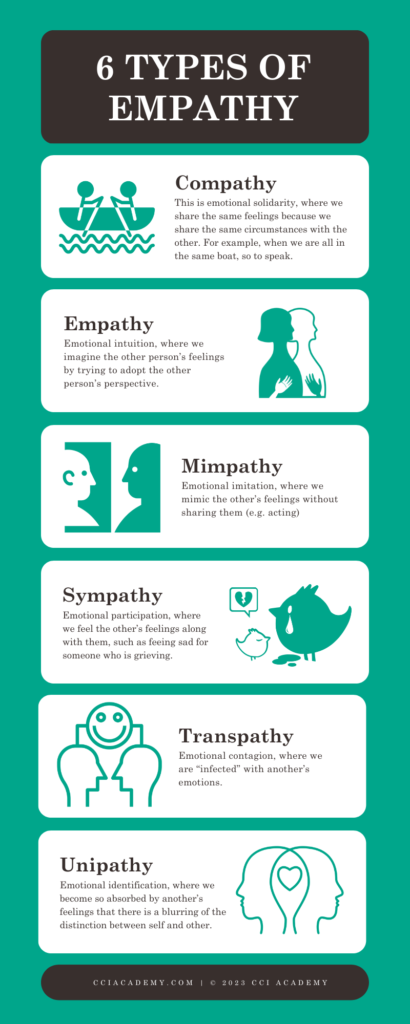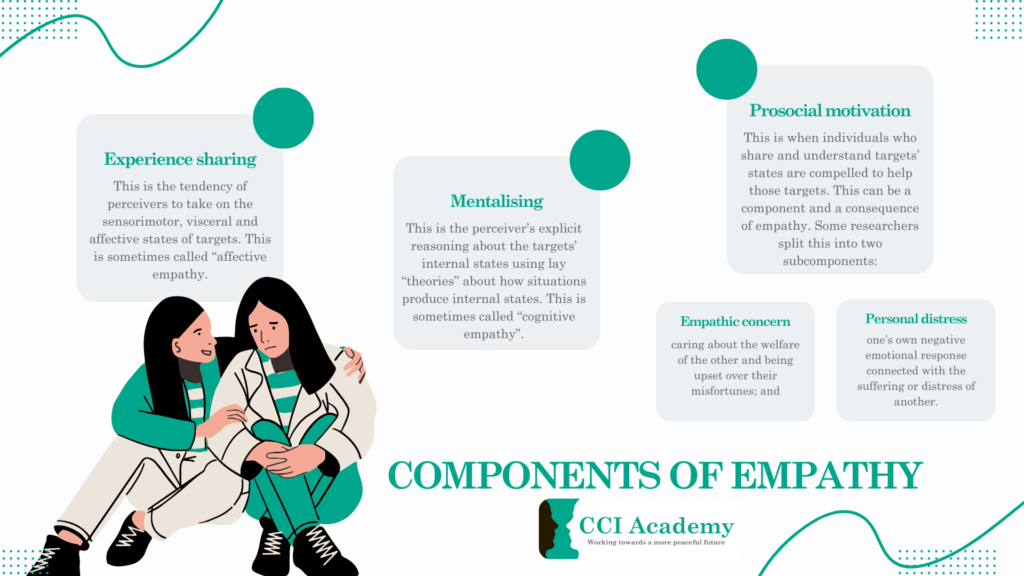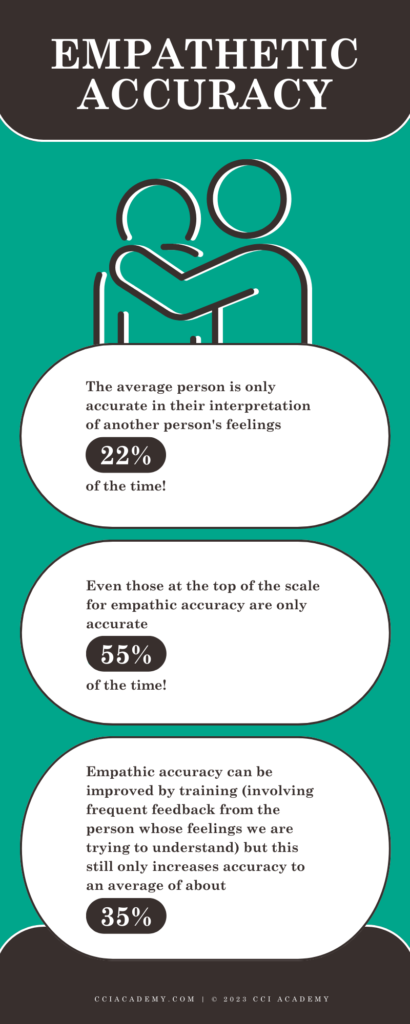HISTORY OF THE TERM EMPATHY
German philosopher Theodor Lipps first introduced the term Einfuhlung (empathy) around 1903 to describe how we should fully appreciate a work of art. His idea was that we should project ourselves into the work and experience it from within, rather than imposing our own frame of reference to interpret the work.
An example of using your own frame of reference to interpret a piece of art can be found in the Rorschach Inkblot Tests, where your experience of the inkblot becomes influenced by your own personal thoughts and feelings (that you project onto the abstract blob of ink to give it meaning).

Interestingly enough, it seems that much in the same way we impose our own frame onto abstract inkblots, we also impose our own frames of reference onto others’ thoughts and feelings when we try to empathise (more about this below).
Subsequently, Max Scheler used the einfuhlung concept to describe the experience of empathizing psychologically with another human being (rather than a work of art). He broke the experience down into six different types of empathy.

All of these different types of empathy involve some kind of sharing of emotions between people, except perhaps for mimpathy which is more about appearing to share another’s emotions than a real attempt to experience them. However, mimpathy can sometimes lead to the actor experiencing the emotions that they were attempting to mimick. For example, method actors are trained to actually experience their characters’ emotions. Is it just a coincidence that so many actors who played characters who were in love in a movie actually ended up in a relationship?
The term empathy relates to what Zaki and Ochsner describe as “the porous nature of emotions shared across interpersonal boundaries”. In other words, empathy is inherently about the social side of emotions, and specifically, recognising the emotions of others. Empathy is the ability and tendency to share and understand others’ internal states.
COMPONENTS OF EMPATHY
Modern definitions of empathy include three related but distinct components:
- Experience sharing. This is the tendency of perceivers to take on the sensorimotor, visceral and affective states of targets. This is sometimes called “affective empathy”. It probably most maps onto Scherer’s concept of “transpathy” but may also involve some “mimpathy”.
- Mentalising. This is the perceiver’s explicit reasoning about the targets’ internal states using lay “theories” about how situations produce internal states. This is sometimes called “cognitive empathy”. This is most like Scherer’s concept of “empathy”.
- Prosocial motivation. This is when individuals who share and understand targets’ states are compelled to help those targets. This can be a component and a consequence of empathy. Some researchers split this into two subcomponents:
- Empathic concern – caring about the welfare of the other and being upset over their misfortunes; and
- Personal distress – one’s own negative emotional response connected with the suffering or distress of another. This component aligns with Scherer’s concept of “sympathy”.

Experience sharing
The first component of empathy, experience sharing, is when the perceiver more or less “feels” the same things as the target. This can include:
- Mimicking others’ bodily postures and facial movements
- Experiencing autonomic arousal when they observe it in targets
- Taking on targets’ moods
- Mirror neurons / neural resonance
These things often happen automatically, rapidly and without conscious awareness.
Mentalising
For the second component of empathy, mentalising, the perceiver combines:
- Information about what they know about how people perceive things
- What they know about how things generally make people feel
- Their observations of the target’s expressions and body language (emotional signalling)
And from these things, the perceiver draws inferences about the target’s underlying emotions, intentions and beliefs.
This is where our own personal “frames of reference” can interfere with accurate empathy.
Mentalising requires conscious cognitive effort, and can be disrupted by absence of attention and time.
EMPATHIC ACCURACY
Empathy requires both experience sharing and mentalising, but ACCURATE empathy also requires consideration of contextual factors such as similarity between targets and perceivers. The more similar the perceiver is to the target, the more likely they are to be accurate with their interpretation of experience sharing and mentalising.
Interestingly, studies that assess how accurate people are at recognising other’s feelings find that on average, people are reasonably accurate only about 22% of the time. Even those who are at the top of the scale for empathic accuracy are only accurate 55% of the time.

EMPATHY AND CONFLICT
Empathy is thought to promote good communication and successful conflict management in ongoing relationships. Empathy can promote conflict avoidance and accommodation (to preserve relationships) but it also promotes problems solving when conflict does need to be engaged with. It may be harder to invoke where there is no ongoing relationship or where a relationship has completely broken down.
It has been suggested that in conflict, the most important element of empathy is perspective taking. The element of personal distress may not be as helpful in promoting constructive interactions.
Empathy may be more useful in individual conflicts (as it’s easier to empathise with one other person, but harder to empathise with a group). Also, intergroup empathy bias may limit the usefulness of empathy in conflict involving groups.
People with trait empathy may be generally more constructive in managing conflict (especially if they have strong skills in taking other people’s perspectives). Higher levels of dispositional empathy are associated with more successful conflict management, dispositional affective empathy was found to be positively linked to problem solving and negatively linked to conflict engagement among adolescent boys and girls. Dispositional affective empathy was not related to the two more passive strategies (withdrawal and compliance).
Effectively managed conflict engagement can also promote empathy, as people who are able to communicate and in particular listen to other people’s perspectives may develop empathy as they increase their understanding of the other’s experience.
Empathy from the conflict support practitioner is also important for building rapport, trust and understanding. However, too much empathy can be problematic in that it can lead to the practitioner losing their impartiality, blurring their role boundaries, and even have a negative impact on practitioner mental health.
FIND OUT MORE
In our Working with Emotions in Conflict online course, there is an entire lesson on Empathy, Sympathy and Compassion and how they relate to conflict. You can find out more about the course here.
The course also includes a 497 workbook filled with terrific content and activities for you to develop your emotional agility!

ADDITIONAL READING:
William Ickes (2003) Everyday Mind Reading: Understanding what other people think and feel. Especially Chapter 4: Measuring Mind Reading in which the author discusses the history of empathy.
Jamil Zaki and Kevin Ochsner (2016) Empathy. Chapter 50 in Barrett, Lewis and Haviland-Jones (Eds.) Handbook of Emotions, 4th Ed.
Karen P. Leith and Roy F. Baumeister (1998) Empathy, Shame, Guilt and Narratives of Interpersonal Conflicts. Journal of Personality 66:1-37.
Olga M. Klimecki (2019) The role of empathy and compassion in conflict resolution. Emotion Review 11(4): 310-325.
Minet de Wied, Susan J.T. Branje and Wim H.J. Meeus (2007) Empathy and conflict resolution in friendship relations among adolescents. Aggressive Behavior 33: 48-55.
James Duffy (2010) Empathy, Neutrality and Emotional Intelligence: A Balancing Act for the Emotional Einstein. QUT Law Journal 10(1): 44-61.

